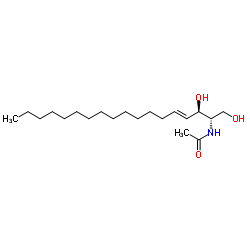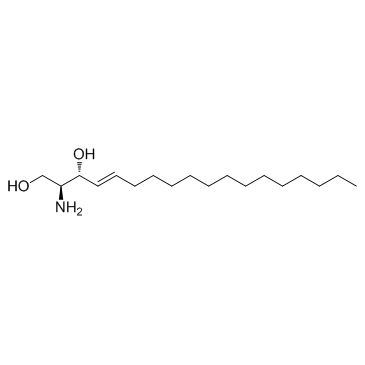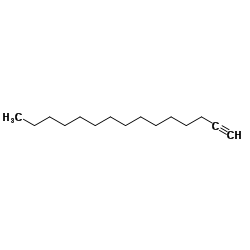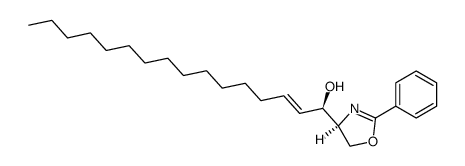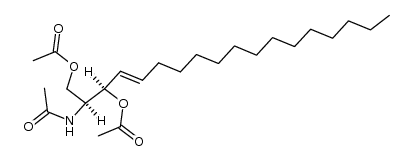3102-57-6
| Name | N-acetylsphingosine |
|---|---|
| Synonyms |
N-Ethanoyl-D-erythro-sphingosine
MFCD00153903 N-ACETYL-D-SPHINGOSINE D-erythro-N-acetyl-sphingosine C14 SPHINGOID BASE C2:0 CERAMIDE CERAMIDE C2 N-ACETYLSPHINGOSINE Acetamide, N-[(1S,2R,3E)-2-hydroxy-1-(hydroxymethyl)-3-heptadecen-1-yl]- C2-D-ERYTHRO-CERAMIDE ACETYL CERAMIDE N-acetyl-sphing-4-enine C2-ceramide Ceramide,N-Acetylsphingosine TOC Ceramide N-acetyl-d-erythro-sphingosine C2 CERAMIDE N-[(2S,3R,4E)-1,3-Dihydroxy-4-octadecen-2-yl]acetamide |
| Description | C2 Ceramide (Ceramide 2) is the main lipid of the stratum corneum and a protein phosphatase 1 (PP1) activator. C2 Ceramide activates PP2A and ceramide-activated protein phosphatase (CAPP). C2 Ceramide induces cells differentiation and apoptosis, inhibits mitochondrial respiratory chain complex III. C2 Ceramide is also a skin conditioning agent that protects the epidermal barrier from water loss[1][2][3][4][5]. |
|---|---|
| Related Catalog | |
| Target |
Protein phosphatase 1[2] PP2A[4] Ceramide-activated protein phosphatase (CAPP)[4] Apoptosis[1] Mitochondrial respiratory chain complex III[1] |
| In Vitro | C2 Ceramide (5 nM-200 µM; 24 hours; primary mouse osteoblasts) treatment (≤500 nM) promots osteoblast viability, whilst concentrations ≥2 µM significantly reduces osteoblast viability in a dose- and time-dependent manner[1]. C2 Ceramide increases cytoplasmic histone-associated DNA fragments by 5.7- and 11.2-fold at 50 µM and 100 µM C2 Ceramide concentrations respectively in osteoblasts. At these higher concentrations, C2 Ceramide is a potent inducer of apoptosis in osteoblasts[1]. C2 Ceramide up-regulates mRNA expression of angiogenic genes in human dental pulp cells (HDPCs) and increases the migration and capillary tube formation of endothelial cells, whereas PP1 small interfering RNA shows opposite effects. Human dental pulp cells (HDPCs) increases levels of bone morphogenetic protein 2, phosphorylation of Smad 1/5/8, and mRNA expression of runt-related transcription factor 2 and osterix[2]. Cell Viability Assay[1] Cell Line: Primary mouse osteoblasts Concentration: 5 nM-200 µM Incubation Time: 24 hours Result: Murine osteoblasts demonstrated a dose-dependent increase in their survival rate when exposed to low concentrations of 5-500 n M. Increasing concentrations of 20-200µM caused a dose-dependent decrease in mitochondrial succinate dehydrogenase activity and osteoblast survival. |
| In Vivo | The PP1 activator C2 Ceramide increases alkaline phosphatase activity, mineralizes nodule formation, and mRNA expression of dentin matrix protein 1 and dentin sialophosphoprotein. In contrast, knockdown by PP1 small interfering RNA inhibits odontoblastic differentiation[2]. |
| References |
| Density | 1.0±0.1 g/cm3 |
|---|---|
| Boiling Point | 532.4±50.0 °C at 760 mmHg |
| Melting Point | 93-96ºC |
| Molecular Formula | C20H39NO3 |
| Molecular Weight | 341.529 |
| Flash Point | 275.8±30.1 °C |
| Exact Mass | 341.292999 |
| PSA | 69.56000 |
| LogP | 5.90 |
| Vapour Pressure | 0.0±3.2 mmHg at 25°C |
| Index of Refraction | 1.485 |
| Storage condition | -20°C |
| Personal Protective Equipment | Eyeshields;Gloves;type N95 (US);type P1 (EN143) respirator filter |
|---|---|
| Safety Phrases | S22-S24/25 |
| RIDADR | NONH for all modes of transport |
| HS Code | 2924199090 |
| Precursor 8 | |
|---|---|
| DownStream 2 | |
| HS Code | 2924199090 |
|---|---|
| Summary | 2924199090. other acyclic amides (including acyclic carbamates) and their derivatives; salts thereof. VAT:17.0%. Tax rebate rate:13.0%. . MFN tariff:6.5%. General tariff:30.0% |
